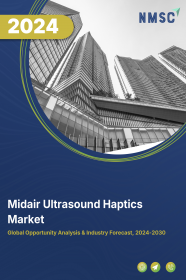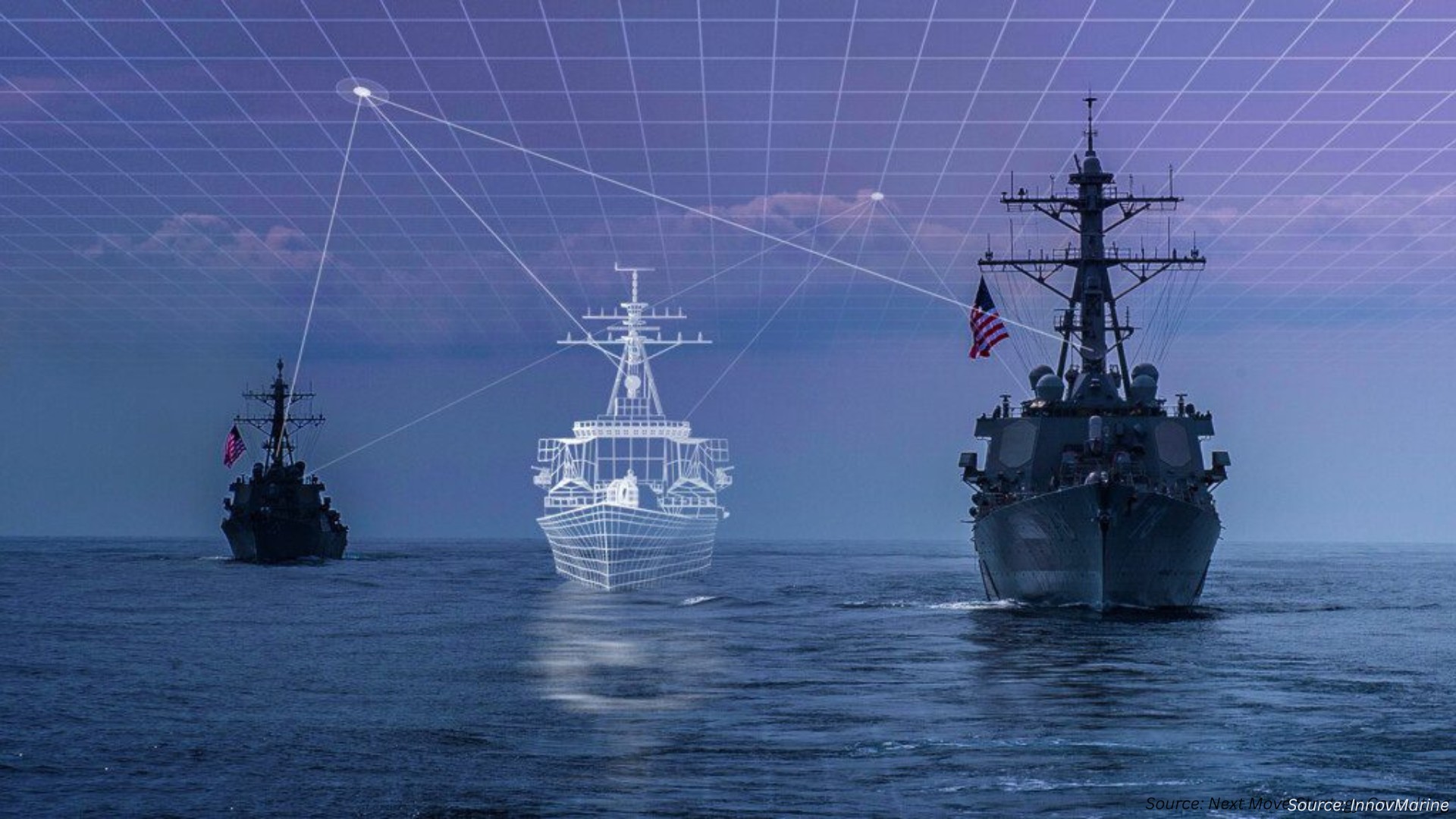
Midair Ultrasound Haptics Market by Component (Transducers, Controllers, Sensors, Amplifiers, and Others Components), by Product Type (Hardware, Software, and Services), by Application (Gaming, AR/VR, Teleoperation, Automotive, Medical Device and Other Applications)- Global Opportunity Analysis and Industry Forecast 2024-2030
Market Definition
The Midair Ultrasound Haptics Market size was valued at USD 12.0 billion in 2023 and is predicted to reach USD 29.7 billion by 2030 with a CAGR of 14.0% from 2024-2030.
Midair ultrasound haptics is a technology that uses focused ultrasound waves to create tactile sensations in midair without the need for physical contact.
This innovative technology allows users to feel virtual objects and textures in three-dimensional space, enhancing the immersive experience in augmented reality (AR), virtual reality (VR), and mixed reality (MR) applications. By modulating the ultrasound waves, midair ultrasound haptics systems can simulate various textures, shapes, and forces, providing users with realistic haptic feedback as they interact with digital content.
Market Dynamics and Trends
The increasing demand for immersive and engaging gaming experiences worldwide is a significant driver of market growth. According to the International Trade Administration, the global gaming industry reached USD 159.3 billion in 2020-21, and it is projected to grow significantly in the forecasted period, fueled by a rising preference for highly immersive and realistic gaming experiences worldwide.
Moreover, the expanding e-commerce industry worldwide is fueling the growth of the midair ultrasound haptic market by providing immersive and interactive online shopping experiences, such as sensation of touching and feeling a product in the virtual world.
According to the latest report from the International Trade Administration, the global e-commerce sector is undergoing significant expansion, with forecasts indicating a market size of USD 5.5 trillion by 2027.
This robust growth in e-commerce presents a lucrative opportunity for the adoption of midair ultrasound haptic technology, as businesses seek to enhance the online shopping experience and differentiate themselves in a competitive market landscape.
Furthermore, the adoption of midair ultrasound haptic technology in medical training and simulation is driving the growth of the market. This technology enables medical professionals to practice procedures in a realistic and immersive environment, enhancing their skills and proficiency.
By providing tactile feedback and simulating real-life scenarios, midair ultrasound haptic technology offers a valuable training tool for healthcare professionals. As the demand for realistic medical training experiences continues to rise, the market for midair ultrasound haptic technology is experiencing accelerated growth. However, the high manufacturing and implementation cost of midair ultrasound haptics is the major factor restraining the growth of the market.
On the contrary, the integration of midair ultrasound haptic technology with augmented reality (AR) and virtual reality (VR) for more immersive and interactive experiences, along with advancements such as the introduction of 6G and web 4.0 to reduce latency, is poised to create significant opportunities for the midair ultrasound haptics market in the coming years.
As 6G networks become more widespread and web 4.0 technologies enable seamless connectivity, the responsiveness and performance of midair ultrasound haptic systems are expected to improve, unlocking new possibilities for applications across various industries, including gaming, education, healthcare, and more, propelling the market growth.
Market Segmentations and Scope of the Study
The midair ultrasound haptics market share is segmented on the basis of component, product type, application, end user, and region. On the basis of component, the market is divided into transducers, controllers, sensors, amplifiers, and others. On the basis of product type, the market is classified into hardware, software, and services. On the basis of application, the market is segmented into gaming, AR/VR, teleoperation, automotive, medical device and others. On the basis of end user, the market is divided into gaming industry, automotive, healthcare, education, entertainment, and others. Regional breakdown and analysis of each of the aforesaid segments include regions comprising of North America, Europe, Asia-Pacific, and RoW.
Geographical Analysis
North America holds the dominant share of midair ultrasound haptics market and is expected to continue its dominance during the forecast period. The presence of a highly advanced and developed gaming industry in the U.S., where new technologies such as virtual reality (VR) and virtual touch are being utilized to develop more immersive gaming experiences, is driving the growth of the midair ultrasound haptic market.
Recently, in February 2023, the U.S.-based gaming company Sony Interactive Entertainment (SIE) launched its new generation of VR headset for an immersive gaming experience. The new VR headset features high-fidelity visuals and haptic sensations to interact with the virtual world, enhancing the overall gaming experience for users, stimulating the demand for midair ultrasound haptic solutions in the region.
Moreover, presence of key market players such as Apple Inc., META, and Immersion Corporation plays a major role in the growth of the midair ultrasound haptic market.
For instance, in February 2024, Apple Inc. launched Apple Vision Pro, a revolutionary Augmented Reality (AR) technology that integrates digital elements into the physical world, creating immersive spatial experiences. The AR features three-dimensional user interface, which responds to natural and haptic inputs, enhancing the way users engage with digital experiences.
On the other hand, Europe is expected to show steady growth in the midair ultrasound haptic market. This is due to the increasing utilization of midair ultrasound haptic technology in Europe's healthcare industry, particularly in medical training to simulate surgical procedures and reduce the need for actual surgeries, is contributing significantly to the expansion of the market.
For example, in 2020, a Switzerland-based company named Force Dimension launched the Sigma.7 robotic arm designed for medical training. It provides haptic feedback to simulate surgical procedures, such as laparoscopic surgery and interventional cardiology, allowing medical professionals to practice complex procedures in a realistic and immersive environment, improving their skills and reducing the risks associated with traditional training methods.
Moreover, as European industries' ongoing investment in digitalization is further propelling the growth of the midair haptic ultrasound technology market in the region.
According to the most recent report from the European Investment Bank, European nations are making significant strides toward digitalization, with 46% of industrial sectors in Europe investing in digital transformation to enhance their operations. As industries seek to improve efficiency, productivity, and user experiences, the demand for midair haptic ultrasound technology is expected to rise steadily across various sectors in Europe.
Competitive Landscape
Various market players operating in the midair ultrasound haptics market include Immersion Corporation, Johnson Electric Holdings Limited, Force Dimension, 3D Systems, Inc., Ultraleap Technology, ZeroLight Limited, META, SPECTRAtech S.A., Haption, Cirrus Logic, Inc., and others. These market players are adopting various strategies such as product launches to remain dominant in the market.
For instance, in January 2022, Emerge launched its first product, the SenseGlove Nova, a hand-tracking glove designed to bring a sense of touch to virtual environments. The device uses haptic feedback to simulate the sensation of touching and holding virtual objects, allowing users to feel and interact with virtual objects in a more natural way in the digital world.
Moreover, in January 2023, HTC launched a high-end virtual reality headset. The new VR glasses and sensory technologies comes with touch and smell features in virtual world. Through this launch, the company aims to enhance customers interaction in the virtual world.
Furthermore, in November 2021, Ultraleap collaborated with Tencent, a Chinese multinational technology conglomerate, and raised USD 82 million for the development of midair ultrasound haptic. The collaboration was aimed toward development of a virtual feel and touch device that can interact with digital content in mid-air using hand gestures and receive tactile feedback through haptic sensations.
Key Benefits
-
The report provides quantitative analysis and estimations of the midair ultrasound haptics market from 2024 to 2030, which assists in identifying the prevailing market opportunities.
-
The study comprises a deep-dive analysis of the robot and midair ultrasound haptics market including the current and future trends to depict prevalent investment pockets in the market.
-
Information related to key drivers, restraints, and opportunities and their impact on the midair ultrasound haptics market is provided in the report.
-
Competitive analysis of the players, along with their market share is provided in the report.
-
SWOT analysis and Porters Five Forces model is elaborated in the study.
-
Value chain analysis in the market study provides a clear picture of roles of stakeholders.
Key Market Segments
By Component
-
Transducers
-
Controllers
-
Sensors
-
Amplifiers
-
Others Components
By Product Type
-
Hardware
-
Software
-
Services
By Application
-
Gaming
-
AR/VR
-
Teleoperation
-
Automotive
-
Medical Device
-
Other Applications
By Region
-
North America
-
The U.S.
-
Canada
-
Mexico
-
-
Europe
-
The UK
-
Germany
-
France
-
Italy
-
Spain
-
Denmark
-
Netherlands
-
Finland
-
Sweden
-
Norway
-
Russia
-
Rest of Europe
-
-
Asia-Pacific
-
China
-
Japan
-
India
-
South Korea
-
Australia
-
Indonesia
-
Singapore
-
Taiwan
-
Thailand
-
Rest of Asia-Pacific
-
-
RoW
-
Latin America
-
Middle East
-
Africa
-
REPORT SCOPE AND SEGMENTATION:
|
Parameters |
Details |
|
Market Size in 2023 |
USD 12.0 Billion |
|
Revenue Forecast in 2030 |
USD 29.7 Billion |
|
Growth Rate |
CAGR of 14.0% from 2024 to 2030 |
|
Analysis Period |
2023–2030 |
|
Base Year Considered |
2023 |
|
Forecast Period |
2024–2030 |
|
Market Size Estimation |
Billion (USD) |
|
Growth Factors |
|
|
Countries Covered |
28 |
|
Companies Profiled |
10 |
|
Market Share |
Available for 10 companies |
|
Customization Scope |
Free customization (equivalent up to 80 working hours of analysts) after purchase. Addition or alteration to country, regional, and segment scope. |
|
Pricing and Purchase Options |
Avail customized purchase options to meet your exact research needs. |
KEY PLAYERS
-
Immersion Corporation
-
Johnson Electric Holdings Limited
-
Force Dimension.
-
3D Systems, Inc.
-
Ultraleap Technology
-
ZeroLight Limited
-
META
-
SPECTRAtech S.A.
-
Haption
-
Cirrus Logic, Inc.




















 Speak to Our Analyst
Speak to Our Analyst
























